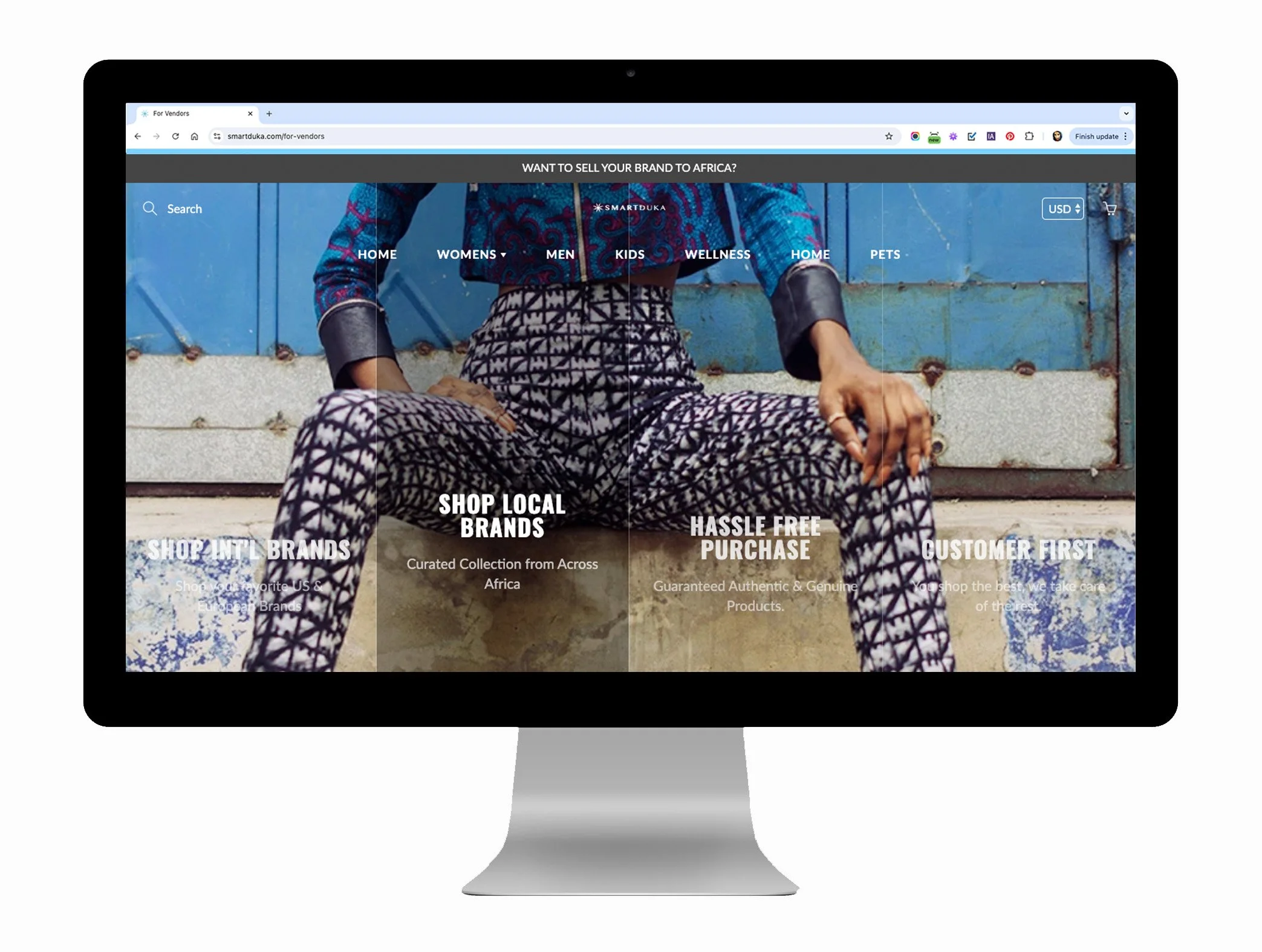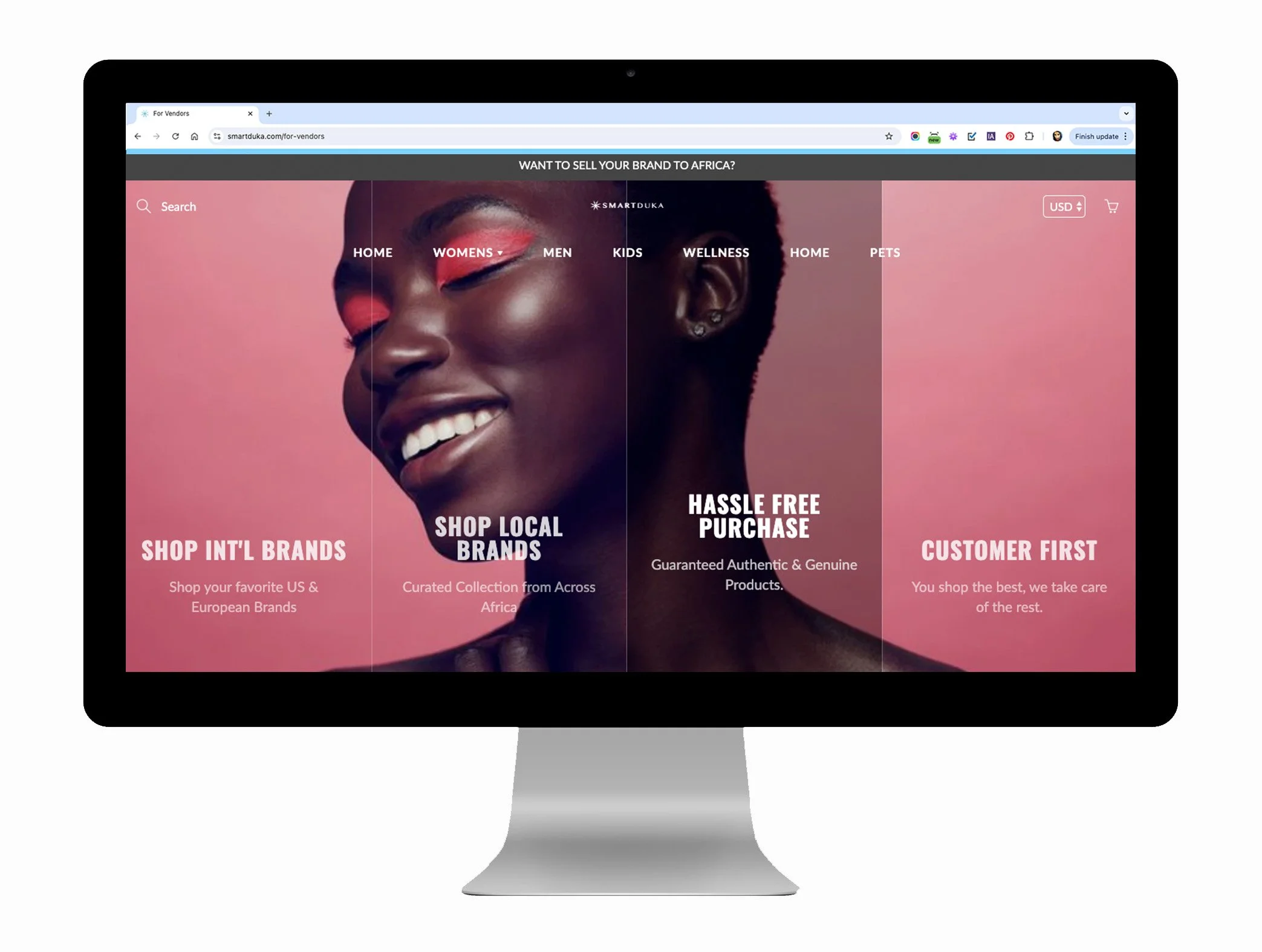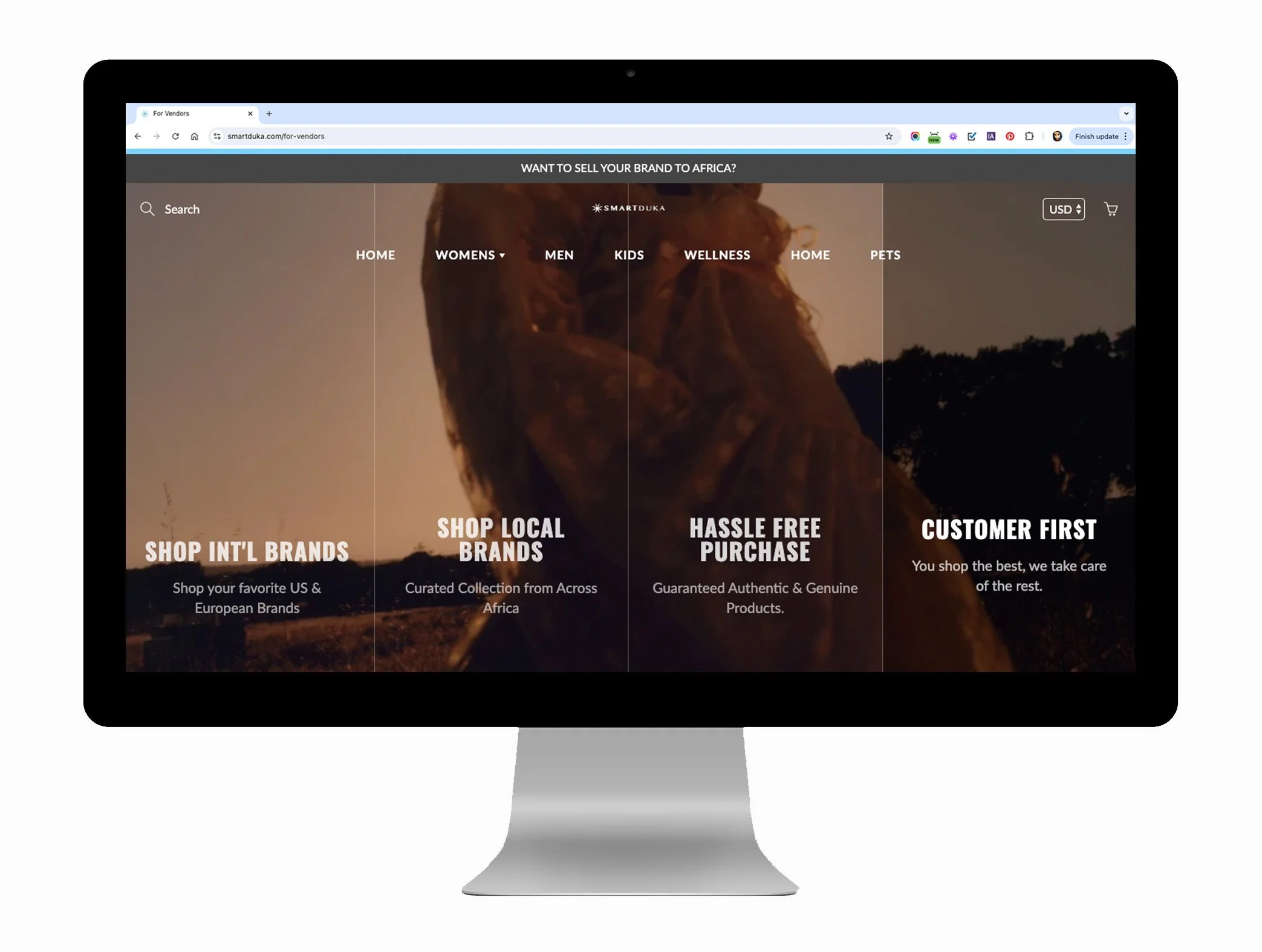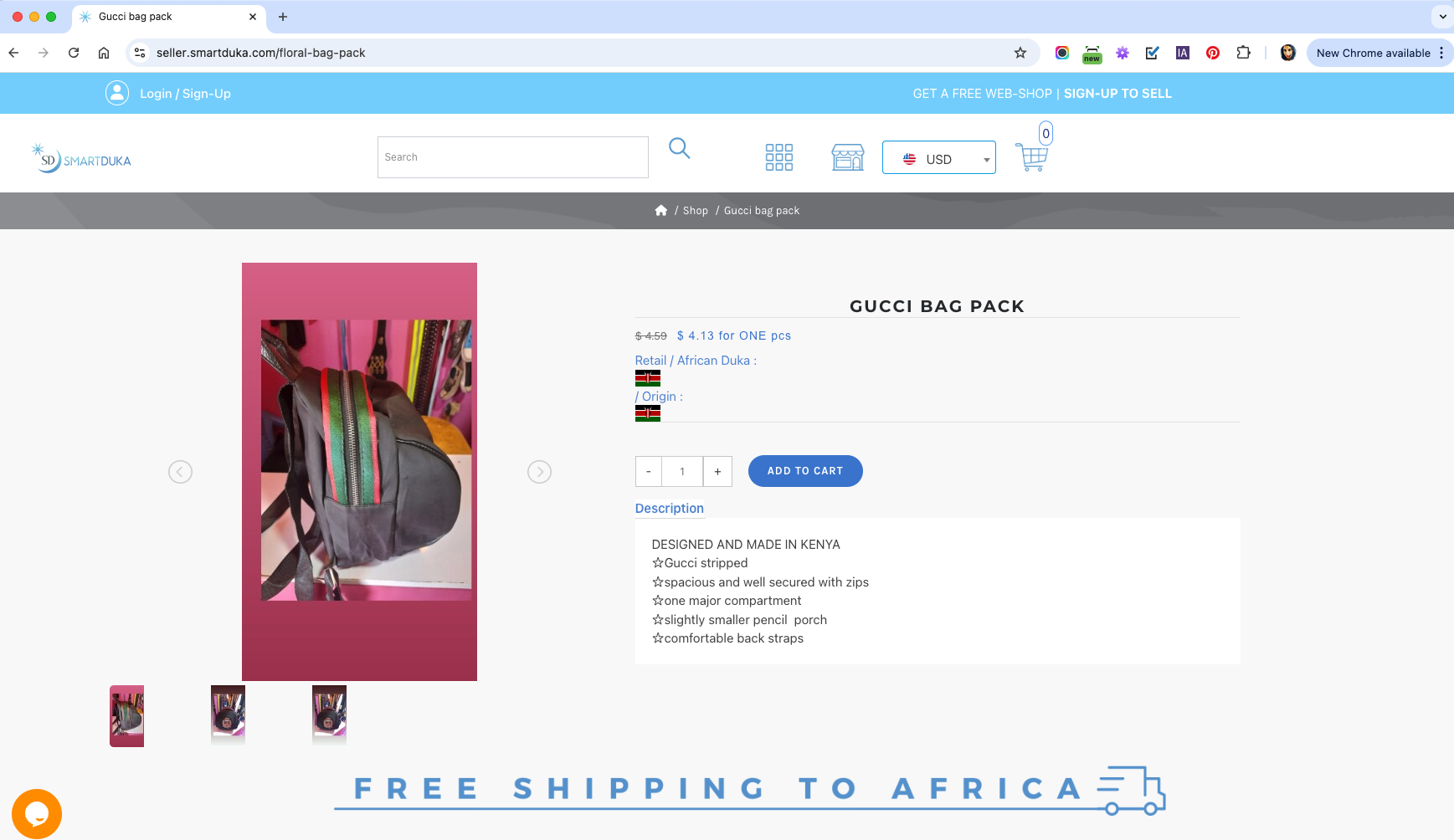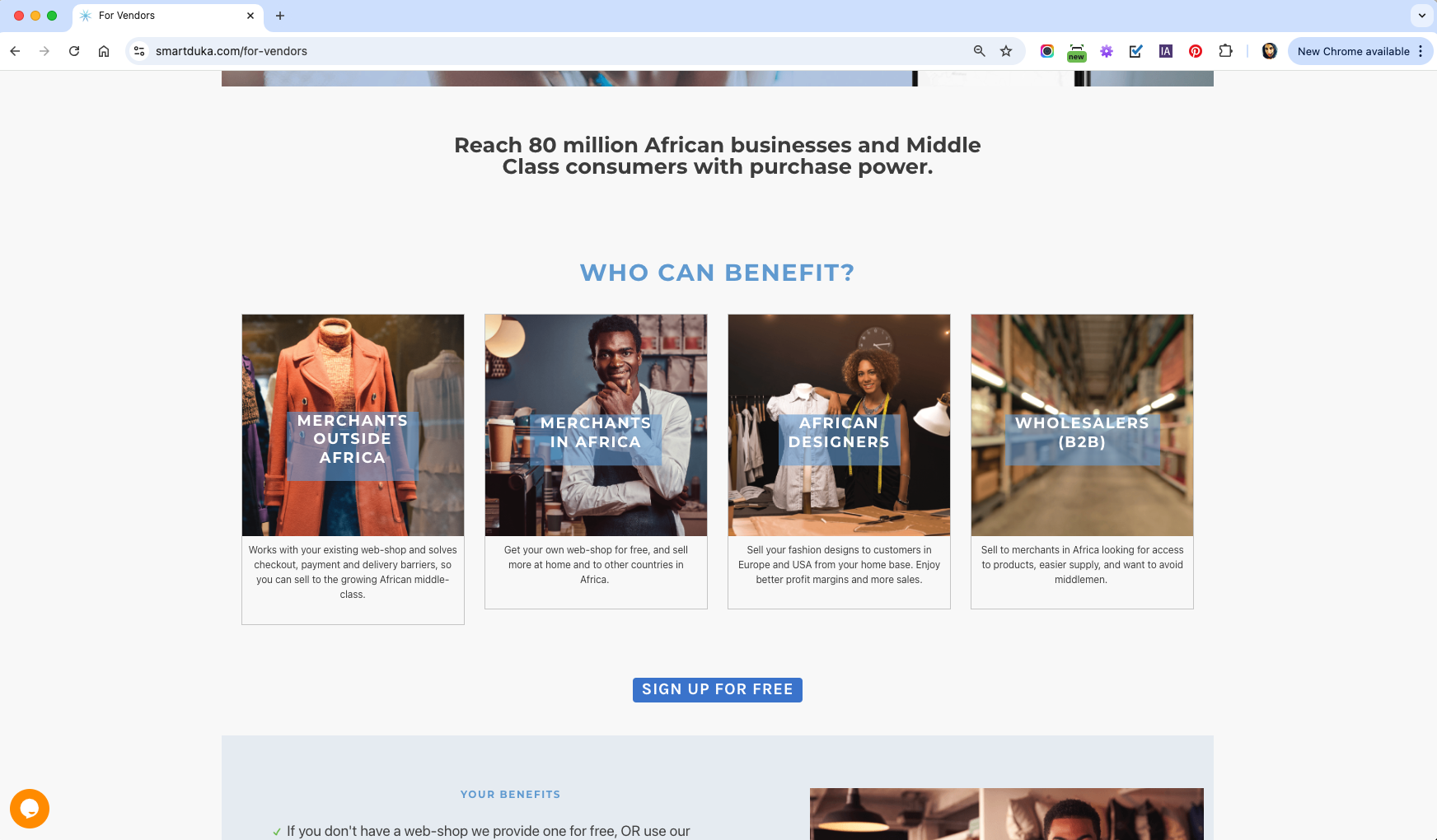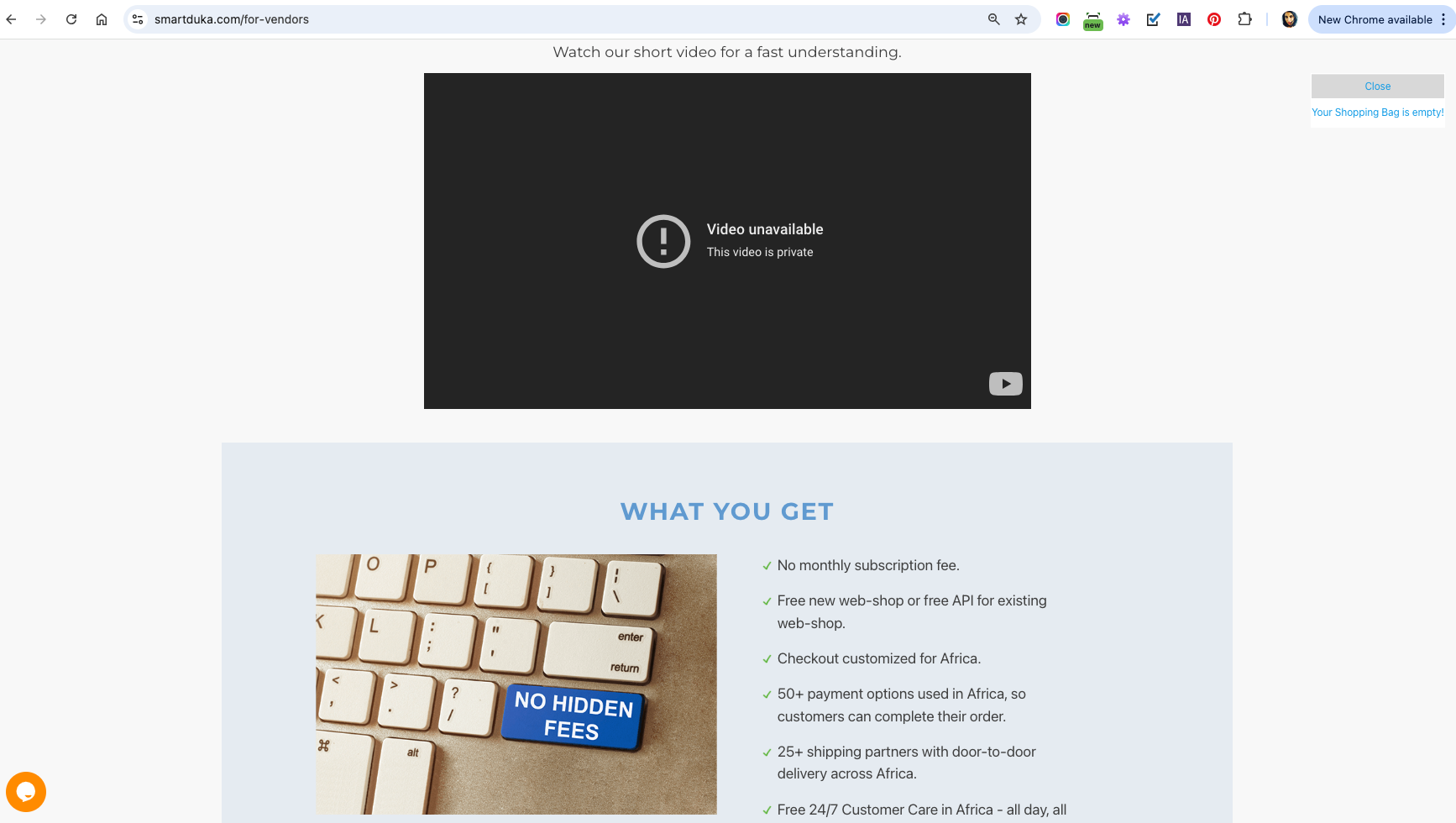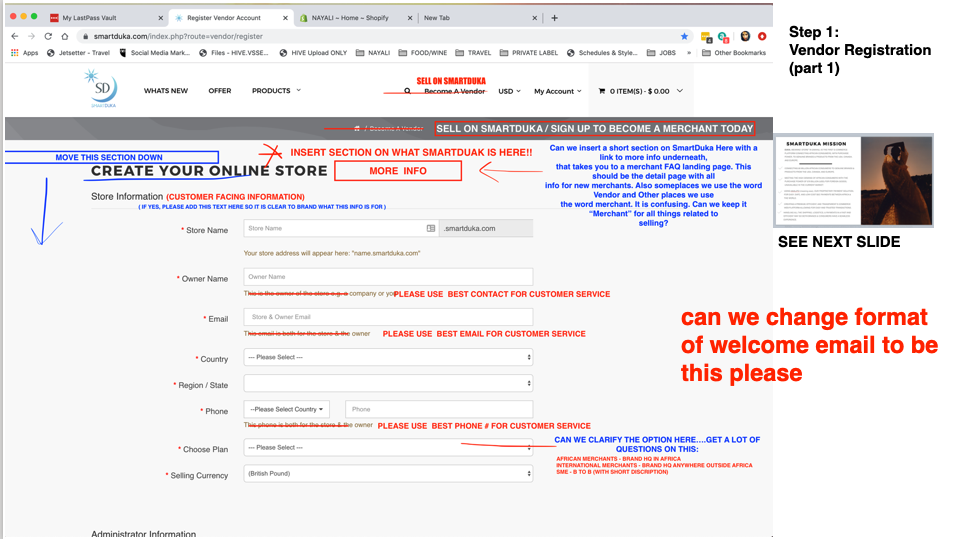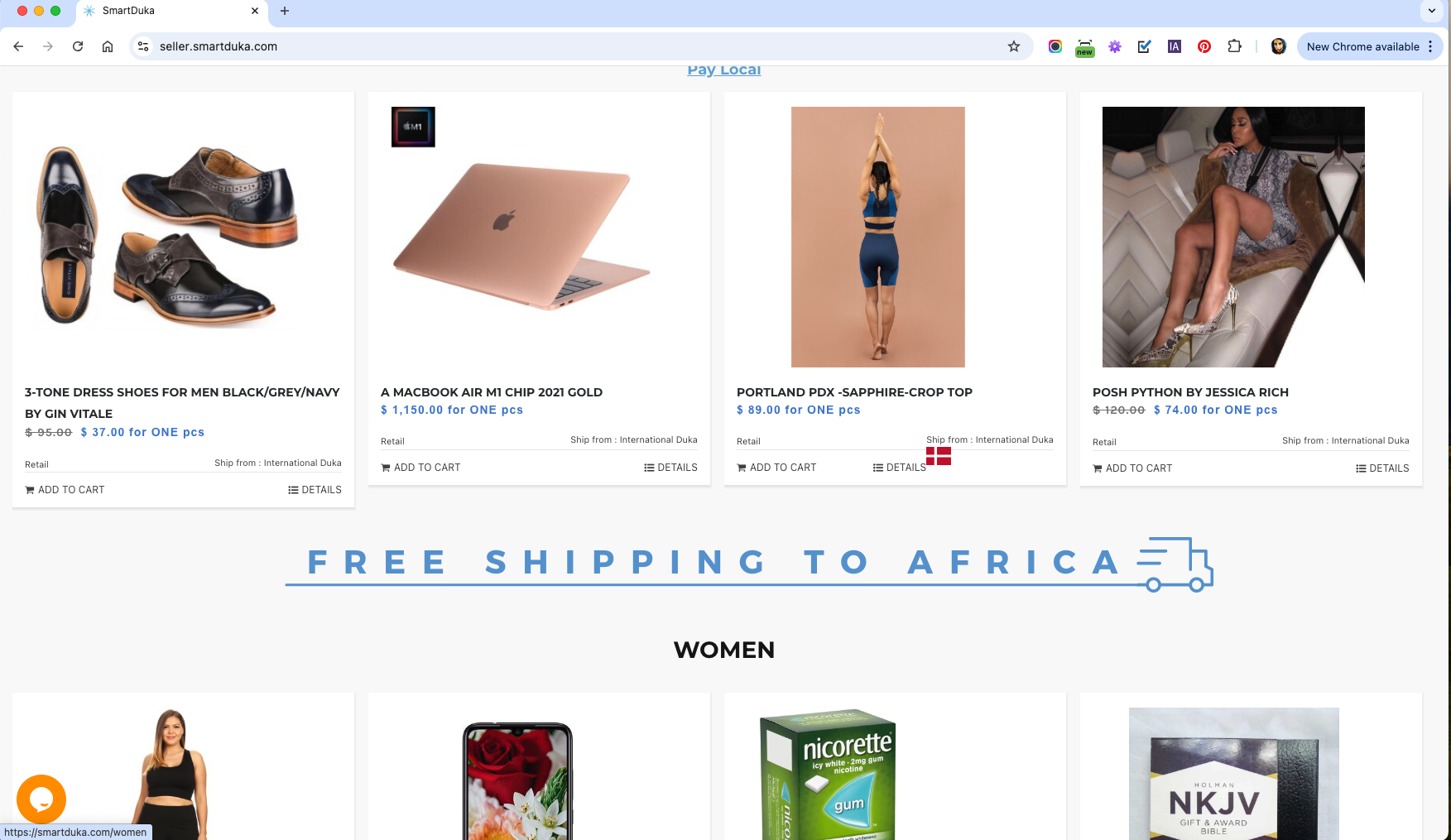
SMART DUKA
Building Trust & Bridging Continents
Between African Consumers & Global Brands
CHALLENGE
Smartduka aimed to onboard premium international brands from the US, Canada, and Europe to sell authentic products to African consumers, and additionally encourage premium local brands to join. However, the main challenge was reluctance from brands to engage with the platform due to significant B2B trust gaps due to inconsistent branding, the unfamiliar onboarding process, limited transparency, and consumer mistrust in the platform’s legitimacy.
SOLUTION
I redesigned SmartDuka’s creative direction, branding, and e-commerce flow to align with international standards, building a platform that promoted transparency, authenticity, and ease of use. Enhancements included an intuitive user interface, a clear shopping experience, and educational content to help users understand the SmartDuka process.
APPROACH
I aimed for a seamless user experience focused on trust, accessibility, and clear merchandising.
Restructured the homepage to showcase international brands for African consumers while promoting local brands to support regional talent and growth.
Redesigned overall creative direction to align with premium international standards.
Introduced visual aids, including a video and diagram, to clarify SmartDuka’s logistics and fees, addressing trust issues.
Created dedicated B2B and B2C links to help vendors and customers onboard and shop, enhancing transparency and reliability.
Results: E-Commerce Redesigned
1. What is SmartDuka? Designed this section to educate users about SmartDuka's mission and purpose.
2. Operational Transparency: Outlines business model and range of services available.
3. Category-Based Merchandising: Created hierarchical merchandise categories (e.g., Men, Women, Kids, Beauty) with accessible links in the top header.
BACKGROUND
DUKA, meaning "store" in Swahili, is the first e-commerce platform connecting 80 million African consumers with a purchasing power of about $78 billion USD, to genuine international brands & products from the USA, Canada, and Europe. The platform leverages a proprietary payment system called Amalipo, which facilitates low-cost, secure transactions and handles logistics, offering a seamless experience for both brands and consumers.
WHAT WENT WRONG?
During the initial rollout, the platform’s branding and onboarding process didn’t fully align with international brand expectations, leading to brand hesitation. Additionally, African consumers found the platform lacking transparency, which impacted trust. These issues were resolved through a comprehensive redesign that prioritized branding consistency, clear communication, and enhanced user experience.
ROLE
Lead UX Designer: research, strategy, re-branding, creative direction, site planning.
CLIENT
TOOLS
Google Surveys, Adobe Suite, Adobe XD, Shopify, Jira.
DURATION
4 Months
DESIGN PROCESS
DESIGN PROCESS
01. RESEARCH
The development of Smart Duka followed a multi-phase research process, which underscored the need for iterative design improvements to meet both consumer and brand expectations. The research aimed to understand user behaviors, payment systems, and logistical challenges to create a robust, user-friendly e-commerce platform.
Phase 1: Initial Research
Ethnographic Research
To better understand the unique challenges African consumers face, we conducted ethnographic research. Amalipo founder Marc Bouviere observed that many African consumers struggled to purchase international goods due to the lack of widely accepted payment systems like Visa or Mastercard. High shipping costs, customs duties, and complex logistics further complicated the shopping experience, making access to international products inefficient and often unaffordable.
Solution
To solve these challenges found in Phase 1, the team developed Amalipo, a proprietary payment and logistics system. This system allows African consumers to purchase international goods at competitive market rates by managing payment conversions, negotiating shipping and duty rates, and overseeing the entire logistics process. By simplifying cross-border transactions for African consumers and brands alike, Amalipo not only addressed the logistical hurdles but also helped build trust in the platform.
Phase 2: Redefining the Problem
The first phase focused on the initial design and development of the Amalipo Payment Solution and the Smart Duka e-commerce platform. The goal was to identify user needs, technical requirements, and create a platform that streamlined cross-border shopping for African consumers. However, once the platform launched, early user feedback revealed significant design shortcomings, which led us to reassess our initial approach.
Redefining the Problem
In response to the issues uncovered during Phase 1, I initiated a second phase of research. This stage involved gathering detailed user feedback through user testing of the current e-commerce site. We aimed to refine the platform’s design, improve the onboarding process for international brands, and enhance the overall shopping experience for African consumers. This iterative process allowed us to pinpoint critical areas that needed improvement, such as trust, transparency, and usability.
Additional Research
Field Studies & Focus Groups
Field studies and focus groups provided additional insights into both the consumer and business sides of the platform. While African consumers faced barriers related to payments and shipping, international brands attempting to enter the African market encountered their own set of obstacles. These included the lack of technology to process African payment types, the complexity of the various African markets and types of users, understanding complicated customs & duties, and general hesitation to utilize a 3rd party e-commerce in a market they don’t understand and with limited ROI information.
B2B User Interviews
To onboard International Merchants, user interviews were conducted to first introduce the SmartDuka platform and how to become a partner. A total of over 200 user interviews were held with potential brands, during which data was collected regarding their brand identity, price points, customer demographics, their sales presence on third-party platforms, and their willingness to sell on SmartDuka. Despite a general openness among brands to attract new customers, there was a noticeable hesitation to join www.smartduka.com. Below are some quotes that illustrate these concerns.
B2B Customer Concerns
“There seems to be a lot of discount products on the site, it doesn’t seem authentic or align with our price point.”
— Clare V.
“The onboarding is really complicated. I can’t bulk edit images, I keep getting errors, and it’s impossible to bulk edit my copy. This will take forever, I don’t think it’s worth the effort right now.”
— Bijou Indochine
“The website quality doesn’t really align with our brand image. I don’t really like how it looks. I would rather just sell from our own e-comm site.”
— Reyn Spooner
“The countries you sell to with the look of the site feels sketchy, I don’t really trust it.”
— Butter Italy
B2B Barriers to Entry
02. STRATEGY
Based on our research, I formulated a strategy to address the key challenges faced by both African consumers and international brands. The strategy centered around building trust, improving transparency, and ensuring a seamless onboarding process.
Define the Users
Personas of African Shoppers
User Pain Points
Revised Problem Statement
Define the Users
Based on initial research insights, the primary challenge was to build trust and streamline the experience for two distinct user groups: African consumers (B2C) and international/local brands (B2B) on the Smartduka e-commerce platform. This stage involved redefining user personas, identifying pain points, and developing a clear problem statement and hypothesis to guide the design process.
USER 1: B2B MERCHANTS
International and African brands looking to sell various products (apparel, beauty, home goods, etc.) on the Smartduka platform.
USER 2: B2C AFRICAN CONSUMERS
Male and female shoppers seeking quality, authentic products from trusted international and local brands.
Personas of African Shoppers
-
The Trend Seeker
This persona spans various demographics but is united by a desire to stay ahead of trends in fashion, technology, and lifestyle. Trend-seekers are often younger individuals who follow social media influencers and are eager to adopt new products.
Shopping Habits: The trend seeker usually utilizes social media platforms and influencers’ recommendations to stay on top of the styles and trends. They shop a combination of emerging brands, vintage designers, and unique finds.

-
The Urban Professional
This persona typically resides in major cities and is characterized by a modern lifestyle and a preference for premium products. They are tech-savvy and often shop online or in upscale retail environments.
Shopping Habits: Urban professionals value quality and convenience, seeking out brands that align with their status. They are drawn to products that enhance their lifestyle and reflect their personal image..

-
The Family Oriented Shopper
This persona is often responsible for household purchases and prioritizes family needs. They may live in suburban or rural areas, focusing on practicality and value for money.
Shopping Habits: Family-oriented shoppers typically look for bulk purchasing options and promotions. They are more likely to compare prices and consider the overall benefits a product offers to their family.

User Pain Points
Revised Problem Statement
CHALLENGE
Create an e-commerce experience that fosters trust and ease for both African Shoppers (B2C) and International/Local Brands (B2B), delivering a high-quality shopping experience that meets the expectations of premium users.
POV
International and African brands seek to connect with African shoppers interested in premium international goods and supporting quality local products, while African consumers desire easy access to authentic, premium products that may not otherwise be accessible locally.
HYPOTHESIS
We believe that an e-commerce platform designed with international-quality UI, clear merchandising, transparent processes, simplified onboarding, and robust authenticity/compliance checks will not only attract international brands looking for additional revenue streams but will also engage African shoppers by meeting their need for trust and convenience on a unified platform.
03.
Opportunity
The Ideation phase involved generating and refining ideas to tackle the key challenges of building trust, improving platform usability, and meeting the expectations of both African consumers and international brands. Guided by the user pain points and the refined problem statement, I prioritized creating a premium, trustworthy shopping experience while simplifying the onboarding and purchasing processes.
Key Design Goals
Ideation Exercises
Brainstorm B2B & B2C Solutions
Merchandise Strategy & User Flow
Concept Prototyping
Key Design Goals
-
Build Platform Credibility
Ensure the site communicates authenticity, high-quality products, and brand alignment.

-
Enhance User Experience
Simplify the shopping flow, navigation, and onboarding process for both B2B and B2C users.

-
Increase Transparency & Usability
Clarify Smartduka’s process, platform value, and customer service resources to reduce user friction.

Ideation Exercises
Ideation exercises were challenging. Most participants were chosen by management from the original Nairobi development team that built the first platform. We tried methods like Round Robin and Quick Ideas, but many struggled to share their thoughts openly, feeling it was disrespectful to critique their colleagues' original work.
LIGHTENING DEMOS
I aimed to diversify the team with international members, younger interns, and B2B vendors who sell abroad. I chose activities that didn’t start as a group. Lightening demos were helpful because team members worked independently & then could showcase new ideas without feeling like they criticized each other. I took notes on important points during the presentations and later organized them to highlight key areas for us to focus on during the design phase.
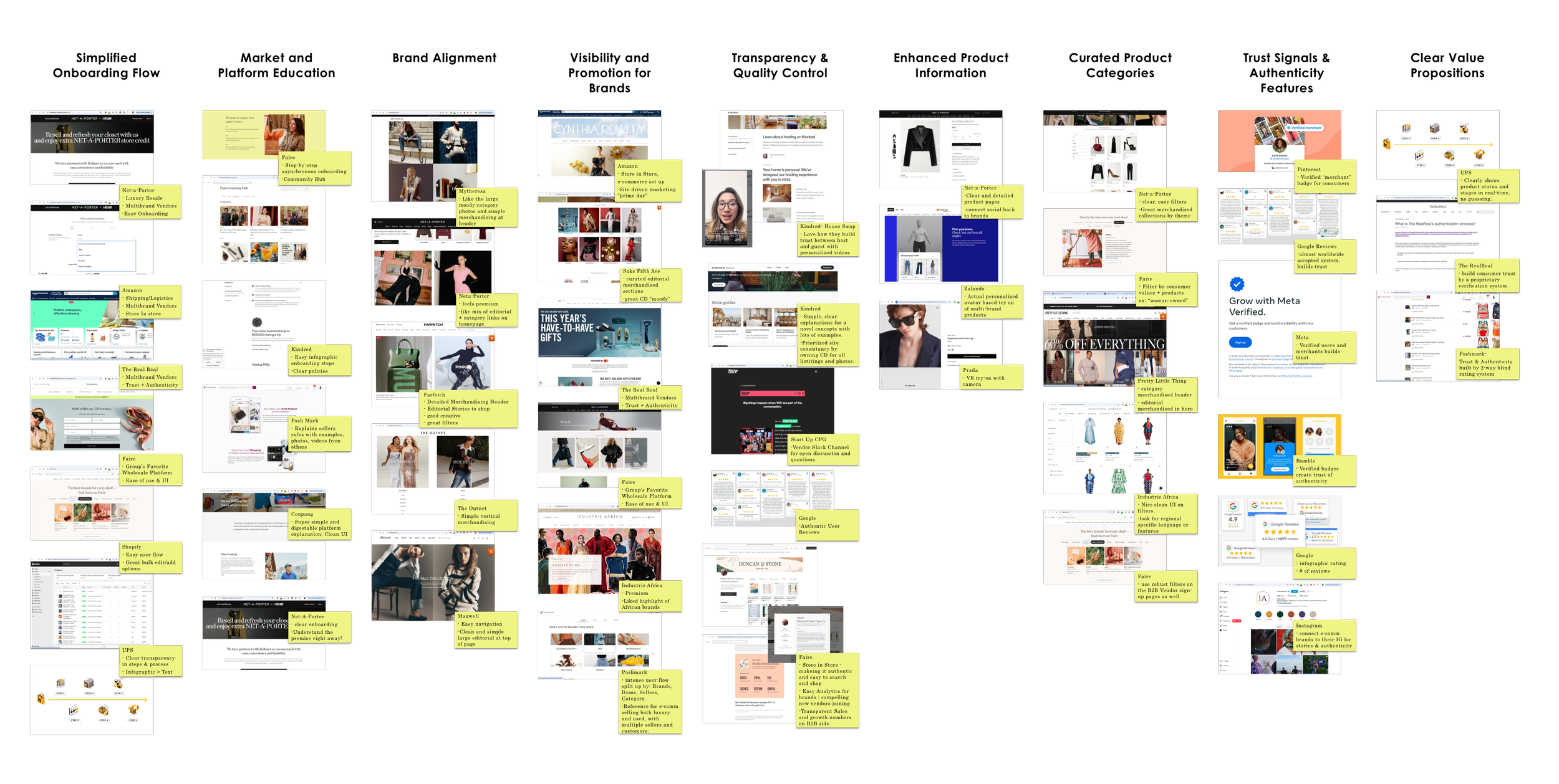
Brainstorm B2B & B2C Solutions
-

Enhanced Product Information
Create detailed product pages with brand info, product specifications, sizing, and a VR try-on feature to increase user confidence.
-

Curated Product Categories
Develop intuitive, hierarchical categories (e.g., Men’s, Women’s, Kids) with robust filters to make it easy for users to find relevant products.
-

Trust Signals and Authenticity Features
Add verification badges, integrate social media links and user reviews & testimonials to connect users to brands.
-

Clear Value Proposition
Include visible explanations of Smartduka’s value versus traditional methods of shopping for international products, highlighting advantages like verified authenticity, customer support, and convenient logistics.
-

Simplified Onboarding Flow
-Implement an asynchronous onboarding option to save time and improve usability.
-Offer onboarding tutorials and a guided setup with a dedicated support agent.
-

Market and Platform Education
Create clear guides and resources that explain the benefits of selling to the African market, the Smartduka process, and the logistics and customer service framework.
-

Brand Alignment and Quality Control
-Redesign the platform’s branding to reflect premium quality and align with international standards.
-Introduce a verification and compliance system to validate products and build trust among merchants.
-

Visibility and Promotion for Brands
Offer B2B brands a “store-in-store” experience, featuring them prominently in curated categories or special collections. e.g., "Must Have Gifts" "Designed in Africa"
Merchandise Strategy & User Flow
The initial launch of the Smartduka platform had a major flaw: it lacked a clear target audience. This confusion affected the product display and design. Our international vendors were uncertain about the target consumers, and African shoppers were unsure what products were available.
Using consumer personas (The Trend Seeker, The Urban Professional, The Family-Oriented Shopper), I developed a clearer merchandising plan that focused on fewer categories but included more filters and options. This approach kept us focused during the design phase and guided the sales team on which brands and products to pursue for the platform.
Concept Prototyping
I created simple wireframes and flowcharts for the Smartduka E-commerce site redesign based on the Key Design Goals and B2B & B2C Ideation Solutions. My focus was on developing a distinct user experience for both B2B and B2C users while maintaining a consistent UI and creative elements to strengthen the brand identity.
04. DESIGN
The design phase translated the strategies and opportunities into tangible solutions. I focused on both the user interface and user experience, ensuring that Smart Duka’s platform was intuitive, aesthetically pleasing, and aligned with international brand expectations.
UX/UI Redesign + New Creative Direction
Previous B2B Onboarding Issues
Redesigned the B2B Onboarding Experience
UX/UI Redesign
New ideas for the homepage's layout, copy, and design.
B2B Onboarding Experience
Ideas for the B2B landing page, services, and user flows.
Simplified Onboarding: Streamlined workflows and provided resources such as tutorials and webinars to support new brands
Store-In-Store: Allows brands to maintain brand identity among the larger e-comm platform and educate consumers.
Product Inventory: Easy ways to add and manage product inventory.
Platform Integrations: This makes it easy for vendors to track inventory and get set up.
Platform Analytics: Allows brands to track sales and check category analysis..
05. TESTING
Testing was an essential step to validate our design changes, ensuring they addressed the problems identified in the research phase and met the needs of both African consumers and international brands.
User Testing
Brand Onboarding Testing
A/B Testing
Iterative Feedback
A/B Testing
Previous B2B Onboarding Issues
No Call to Action: Headers are ineffective, lacking action links; icons confuse users; categories are not promoted.
Design Problems: Low-quality images and videos, poor layouts imply a lack of quality; links do not work.
Complex Content: The text is too heavy and hard to understand; links to more information are missing. Poor formatting makes the site seem untrustworthy.
User Issues with Onboarding: Signing up as a vendor is overly complicated, often leading to technical errors.
Lack of Support: Onboarding offers no help or progress updates, causing vendors to give up on joining the platform.


